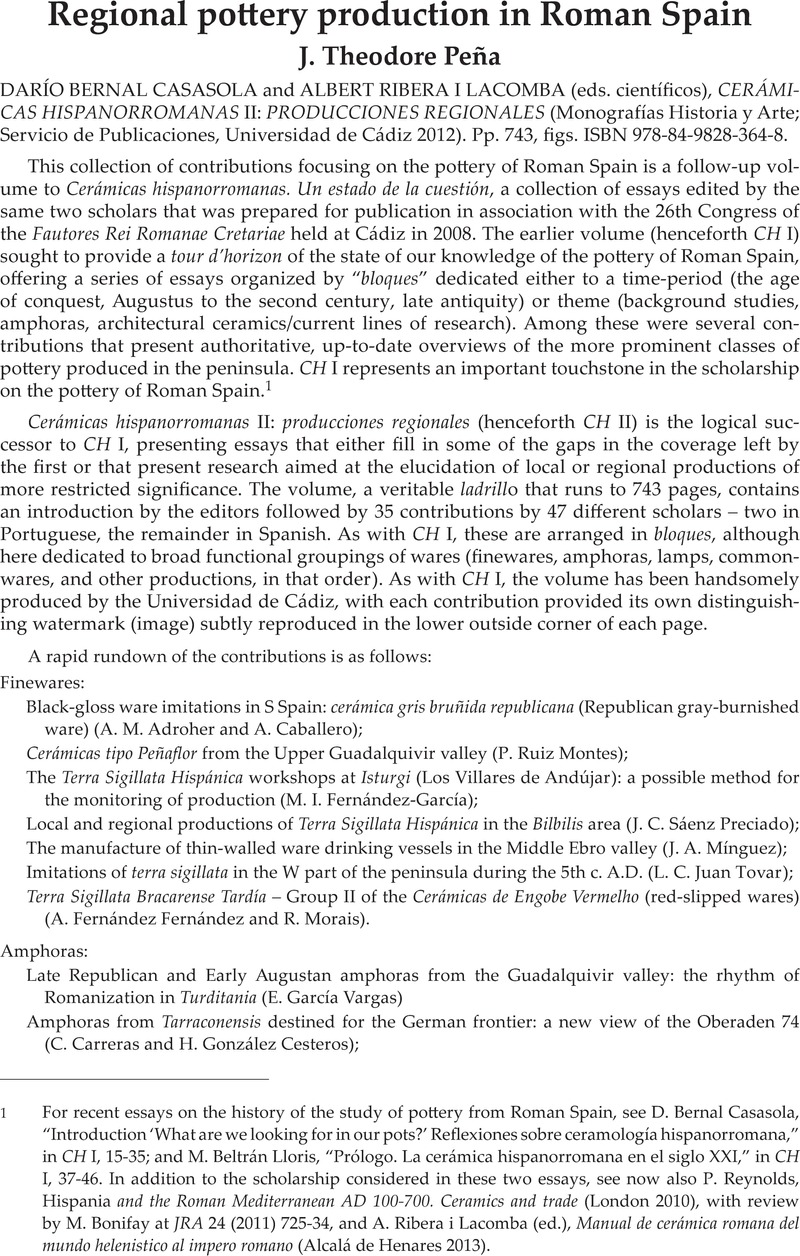Article contents
Regional pottery production in Roman Spain - DARÍO BERNAL CASASOLA and ALBERT RIBERA I LACOMBA (eds. científicos), CERÁMICAS HISPANORROMANAS II: PRODUCCIONES REGIONALES (Monografías Historia y Arte; Servicio de Publicaciones, Universidad de Cádiz 2012). Pp. 743, figs. ISBN 978-84-9828-364-8.
Published online by Cambridge University Press: 27 November 2014
Abstract

- Type
- Reviews
- Information
- Copyright
- Copyright © Journal of Roman Archaeology L.L.C. 2014
References
1 For recent essays on the history of the study of pottery from Roman Spain, see Casasola, D. Bernal, “Introduction ‘What are we looking for in our pots?’ Reflexiones sobre ceramología hispanorromana,” in CH I, 15–35 Google Scholar; and Lloris, M. Beltrán, “Prólogo. La cerámica hispanorromana en el siglo XXI,” in CH I, 37–46 Google Scholar. In addition to the scholarship considered in these two essays, see now also Reynolds, P., Hispania and the Roman Mediterranean AD 100-700. Ceramics and trade (London 2010)Google Scholar, with review by Bonifay, M. at JRA 24 (2011) 725–34Google Scholar, and i Lacomba, A. Ribera (ed.), Manual de cerámica romana del mundo helenistico al impero romano (Alcalá de Henares 2013)Google Scholar.
2 The grooves that make up the letters are sharply incised with flaking along their edges, and are devoid of slip, in marked contrast to the adjacent surfaces, which display well-preserved slip.
3 For these items, see Mackensen, M., “Technology and organization of ARS ware production-centres in Tunisia,” in Humphrey, J. (ed.), Studies on Roman pottery of the provinces of Africa Proconsularis and Byzacena (Tunisia) (JRA Suppl. 76, 2009) 21-28 and 40–41 Google Scholar. For potter’s ribs from the Potter’s Quarter at Sagalassos (employed for the manufacture of Sagalassos Red Slip ware) fashioned from sherds and showing pronounced edge wear (including at least two fashioned from a sherd of that ware, and some bearing graffiti), see Murphy, E. and Poblome, J., “Technical and social considerations of tools from Roman-period ceramic workshops at Sagalassos (southwest Turkey): not just tools of the trade?,” JMA 25.2 (2012) 200–7CrossRefGoogle Scholar. For potter’s ribs fashioned from sherds of Italian sigillata by having a hole drilled through them (none bearing a graffito, most with visibly worn edges) from the Italian sigillata workshop of Cn. Ateius at Arezzo, see Sternini, A. (ed.), La fortuna di un artigiano nell’Etruria romana (Grosseto 2012) 38, 42 figs. 27-28Google Scholar.
4 This ware appears to be identical to Early Roman Ware 3, a production that Reynolds identified in his survey of the Vinalopó valley in Alicante, for which he posited an origin at Ilici (Elche).
5 Overlooked is the 3rd c. A.D. production of wheel-made lamps around Rome, attested at both Rome and Ostia; see Peña, J. T., The urban economy during the Early Dominate: pottery evidence from the Palatine Hill (BAR S784; Oxford 1999) 100 Form 29.2, no. 67Google Scholar; Carandini, A., Fabbricotti, E. and Gasparri, C. (edd.), Ostia 1. Le Terme del Nuotatore: scavo dell'Ambiente IV (StMisc 13, 1968) 85 fig. 259a-bGoogle Scholar.
6 This work has since appeared as Delgado, M. Esteban et al., La cerámica común romana no torneada de difusión aquitano-tarraconense (s. II a.C. – s. V. d.C.) (Kobie Serie Anejos no. 12; Bilbao 2012)Google Scholar (non vidi).
7 I only regret that, after mentioning that one of the rural sites in question (Rasero de Luján, located c. 5 km southwest of Segobriga) produced evidence for the manufacture of ceramic beehives, the authors fail to discuss this.
8 An important work on ancient apiculture not cited is Giuman, M., Melissa: archeologia delle api e del miele nella Grecia antica (Archeologica 148; Rome 2008)Google Scholar.
- 1
- Cited by




